
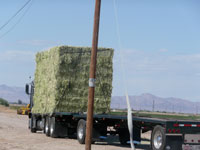
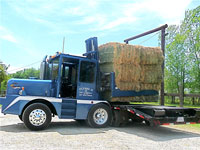
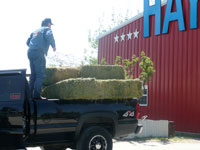

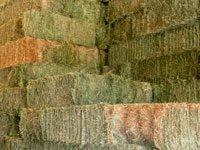
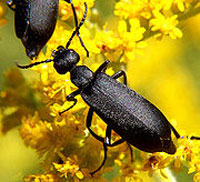

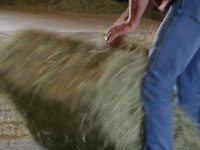
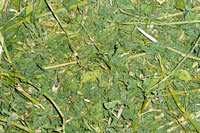
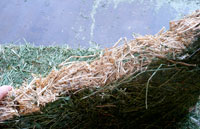

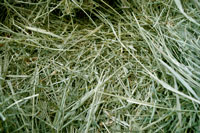
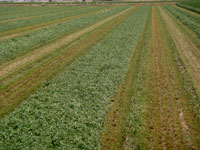
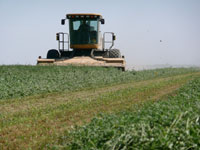
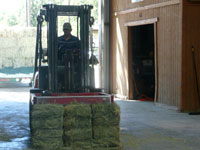
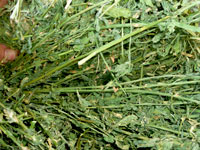
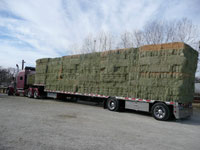
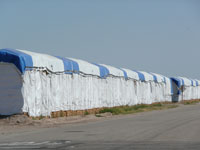
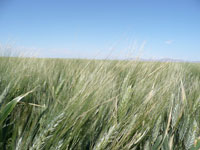
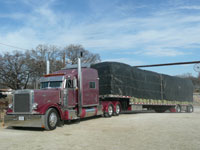
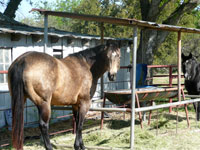

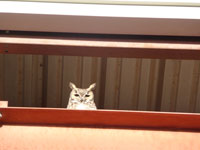
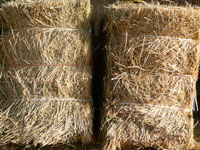
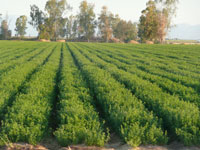


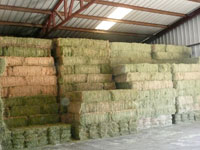
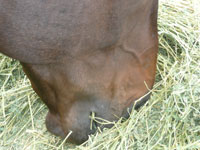
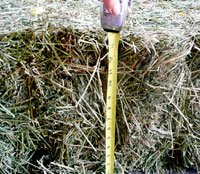
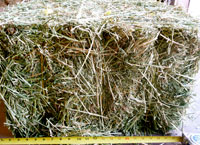
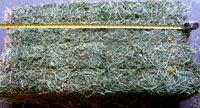
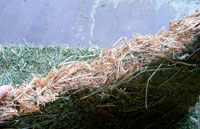
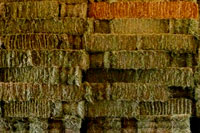
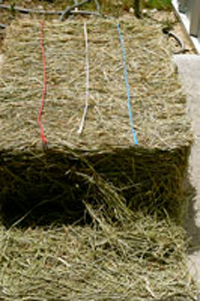
Hay Terminology:
A dump: This terminology is used on loading trucks, counting hay inventory and stacking hay roadside. Each dump of hay consist of 68 bales of hay per “dump”. The bottom row is on edge consisting of 12 bales. Each row on top of that is made of 8 bales patterns. The dump is 8'x8' square. When ordering a semi load of hay, we load 6 dumps of hay on a 48' flat bed for long distance domestic shipping. On a set of doubles it is 8 dumps.
A Squeeze: A truck that picks up 56 to 68 bales at a time and loads and off loads semi trucks. A squeeze is driven as an independent truck and is legal on all highways. A squeeze has two large hydraulic arms that are 10' long that squeeze a dump of hay to be loaded and off loaded. It takes a squeeze driver 30 minutes to load a semi truck with hay.
A ton: 2000# pounds of hay to the ton. A retail three string bale weighs 100 # there are 20 bales in a ton. A "feed store ton" can be 16 bales. A semi holds 24 tons on a truck.
Bale
sizes:
Bale size: 3 string 100 # to 140# to
140# 22” x 15” x 44”
Bale size: 2 string 40 # to 75 #
19” x 16” x 36”
One ton bales: 2000# 4’ x 4’ x
8’
Half ton bales: 1000# 3’ x 4’ x
6’
Round bales: 850 to 1100# 4x4 or
4x5
Back to top
Bleached: Sun bleached hay on the outside of a stack or bale. This does not lower the integrity of the hay if it is fresh. The hay will turn a clean yellow color. It is similar to the "crust on toast" only affecting a thin layer on the outside of the bale, having little effect on the nutritional analysis.
Blister Beetles: Blister beetles have an oily substance, cantharidin, in their body fluid that causes large blisters to form when a beetle is crushed.
Cantharidin can cause sever inflammation and the formation of blisters on the skin. If absorbed through the intestines, symptoms can include inflammation, blisters in the mouth, straining, temperature, increased heart rate and respiration, sweating, diarrhea and frequent urination within the first 24 hours.
This is accompanied by secondary infection and bleeding. Calcium levels in the horses may be drastically lowered and heart muscle tissues destroyed. Animals can die within 24 to 72 hours, so it is imperative to contact a veterinarian as soon as a blister beetle poisoning is suspected.
Bucking hay: is a type of manual labor where hay bales, usually 65 lb. to as much as 140 lb., are stacked by hand in a storage area such as a barn, or stacked on a vehicle for transportation. The act of throwing the bales up to a higher level is called "bucking." The work is very strenuous. Practicing a proper technique with hay hooks will reduce fatigue and injury.
Cakie: A
hard bale that looks compressed. It is the result of too much moisture
during the baling process and too much hay in the bale. It is not appealing
to the eye or to the touch. It will feed.
Back to top
Cantharidin: The poison that the Blister beetles produces which is usually fatal for horses. It is comparative to cyanide. A few beetles consumed in a single feeding of alfalfa hay may be lethal.
Chaff: The loose hay that falls to the ground after cutting open a bale. Also Chaff hay is dried forage that has been cut into small pieces and bagged. As the forage is cut into short lengths it can be eaten quickly in contrast to hay and pasture. Good quality chaff should smell fresh, not be dusty and have no obvious contaminants.
Chemical
Conditioners: Some hay producers use a yeast product, others
a salt product to maintain the high color and to dry the hay faster
after cutting. The chemicals are sprayed onto the hay to speed evaporation
of moisture. These are expensive techniques and used in areas where
there is a combination of modern technology, high prices for hay,
and too much rain for hay to dry properly.
Back to top
Clean: Free of Weeds, dirt, debris and foreign material.
Colic in horses: is defined as abdominal pain, but it is a clinical sign rather than a diagnosis. The term "colic" can be unvolved in many painful conditions, not just in the gastrointestinal system. The most common forms of colic are gastrointestinal in nature and are most often related to colonic disturbance. There are a variety of different causes of colic, some of which can prove fatal without surgical intervention. Colic surgery is usually an expensive procedure as it is major abdominal surgery, often with intensive aftercare. Among horses, colic is a major cause of premature death. The incidence of colic in the general horse population has been estimated between 10 and 11 percent on an annual basis.
Compressed hay: Regular size 22x15x44 bales that have been compressed and re-baled, sliced for efficiency to gain weight per square foot for shipping over seas in containers usually for export hay.
Crop
rotation: is the practice of growing a series of dissimilar
types of crops in the same area in sequential seasons for various
benefits such as to avoid the build up of pests that often occurs
when one species is continuously cropped. Crop rotation also seeks
to balance the fertility demands of various crops to avoid excessive
depletion of soil nutrients.
Back to top
Flake: The way a bale splits. There should be about 17 flakes in a three string bale. A good flake should weigh about 8 # and makes a good feeding as long as the weight is there; always feed by weight!
Good Color: Hay that is bright to the eye. Judge the inside of a bale color, not the outside. Hay is bleached by the sun in 72 hours from baling time and the nutritional value is not depleted. Quality hay can be bleached out on the outside of the bale. When the bale is opened, it will be bright and clean.
Good Fiber Content: For founder, overweight, sugar intolerant and colicky horses good fiber content is important and it is found in all good forage.
Good Leaf to Stem Ratio: Leafiness is an excellent indicator of hay quality because 60% of the total digestible nutrients, 70% of the protein, and 90% of the vitamins are found in the leaves. A high percentage of leaves indicate good harvest and handling methods.
Good
Quality hay: Medium color, clean, medium stem, not too coarse
and has a good stem to leaf ratio, palatable.
Back to top
Hay: is a generic term for grass or legumes that have been cut, dried, and stored for use as animal feed, particularly for grazing animals like cattle, horses, goats and sheep. It is cut in the field and then dried and baled for storage. Hay is most nutritious when it is cut early on, before the seed heads are fully mature and before the stems of the plants become tough and thick. Hay that is very green can be a good indicator of the amount of nutrients in the hay; however, color is not the sole indicator of quality - smell and texture are also important. Hay can be analyzed by many laboratories and that is the most reliable way to tell the nutritional values it contains.
Hay Conditioner: is a machine that crimps and crushes hay to promote faster and more even drying. A conditioner is made up of two rollers which the hay is forced through causing the stalks to split, thus giving more service area for moisture to escape. A crimper / conditioner, breaks the stem and rolls out the moisture from the plant, giving the producer the opportunity to bale their hay sooner because the hay cures quicker. It creates a soft hay and maintains good color. This also kills the blister beetle ! Beware!
It doesn't take very many blister beetles to poison a horse. These insects are especially a problem in alfalfa hay that is crimped when is cut. As you crush the hay you kill any toxic beetles in the hay. If you do not crimp, the beetle is more likely to survive and can crawl away before the baler comes along.
Hay
Process: Plant, fertilize, cut, rake, cure, bale, farm stack,
truck, store stack, haul home, home stack, feed. Clean up manure!!
Back to top
Herbicide: is used to kill unwanted plants. Selective herbicides kill specific targets while leaving the desired crop relatively unharmed. Some of these act by interfering with the growth of the weed and are often synthetic "imitations" of plant hormones. Weed control is the botanical component of pest control, stopping weeds from reaching a mature stage of growth when they could be harmful to livestock by physical and chemical methods.
Impaction: Impaction is often caused by coastal hay and horses not drinking enough water in the winter months with the addition of lack of exercise. Impaction colic is almost always food related. Impaction colic is just what it sounds like - an impaction of food (a blockage caused by non digestible food) in the intestines. Horses who bolt or gulp down their food as well as horses who have problems with their teeth are at a high risk of impaction colic because their food isn't properly digested which can cause impaction and blockages. Worm infestation can also cause impaction. Consult with a veterinarian for the best wormer and schedule for your horse. Another cause of impaction colic is the horse ingesting too much dirt and/or sand. You can help prevent this by feeding your horse hay on the ground in a grassy area only, not sandy areas. In stalls keep them away from eating on sand. Use mats, feeders and shavings around feeding area. Always use a bucket for your feed.
Insecticides: Pest
/ insect control refers to the regulation or management of a pest,
usually because it is perceived to be detrimental to a person's or
animals health, the ecology or the economy. Pest control is at least
as old as agriculture as there has always been a need to keep crops
free from pests in order to maximize food production.
Back to top
Minerals: are required for maintenance and function of the skeleton, nerves and muscles. These include calcium, phosphorus, sodium, potassium and chloride. Horses also need trace minerals such as magnesium, selenium, copper, zinc and iodine. Normally, if adult animals at maintenance levels are consuming fresh hay and are on pasture, they will receive adequate amounts of minerals in their diet, with the exception of sodium chloride (Salt), which needs to be provided, preferably free choice. Some pastures are deficient in certain trace minerals, including selenium, zinc and copper. Health problems may occur if horses' trace mineral intake is not properly supplemented. Calcium and phosphorus are needed in a specific ratio of between 1:1 and 2:1. Adult horses can tolerate up to a 5:1 ratio, foals no more than 3:1. A total ration with a higher ratio of phosphorus than calcium is to be avoided. Over time, imbalance will ultimately lead to a number of possible bone-related problems such as osteoporosis. Foals and young growing horses through their first three to four years have special nutritional needs and require feeds that are balanced with a proper calcium:phosphorus ratio and other trace minerals. A number of skeletal problems may occur in young animals with an unbalanced diet. Hard work increases the need for minerals; sweating depletes sodium, potassium, and chloride from the horse’s system. Therefore, supplementation with electrolytes may be required for horses in intense training, especially in hot weather.
Mold in hay: Spoiled hay has a disagreeable moldy odor that is created from improper moisture control either during the baling process or from exposure to moisture during storage. Mold can be detected by sight; as white spores or a mold dust. Mold is deadly to horses.
Organic
farming: is a form of agriculture that relies on crop rotation,
green manure, compost and biological pest control to maintain soil
productivity and control pests, excluding or strictly limiting the
use of synthetic fertilizers & pesticides. Organic agriculture
sustains the health of soils, ecosystems and people. Organic agriculture
combines tradition, innovation and science to benefit the shared
environment.
Back to top
Over mature hay: No matter what type of hay it is, over mature hay is never good horse hay. Over mature hay can encompass many areas, from the stance of hay to the cutting cycle. Over mature hay is the number one reason for impaction for horses.
Premium Cutting: is done in a 28 day cutting cycle.
Premium hay: Safe, green, fresh, and soft, with a fine stem and a excellent stem to leaf ratio. The flake will hold its integrity. It will have a clean aroma and a palatable texture.
Poor Quality hay: Dry, poor color, over bleached, coarse-stemmed with poor aroma and feel. There is little leaf, heavy stem and the leaf falls off of the stem. It may be moldy, dusty or rotting.
Protein: Alfalfa and other legume hays are a good source of protein that can be easily added to the diet. Higher protein is important for lactating mares and young growing foals.
Rained
on hay: Weather damaged hay that is poor in color: the outside
of the bale will have a gray tinge. The inside of the bale can have
mold or "slugs." Rained on hay can be very dangerous even
when dried. The mold spores inside are deadly to horses. We recommend
disposing of this type of hay.
Back to top
Retail hay: A lighter three string bale sold by the feed store on the west coast. Average bale weight 100#. This hay is easy to handle and good to premium quality.
Ropy: Very mature Bermuda hay that has the texture of rope.
Round bales: Hay baled in a round shape weighing approximately 1000# to accommodate the ability to free feed cattle, horses and clean up fields. it is most customary that round bales are a more mature hay verses small squares. Round bales are the #1 reason for impaction in horses.
Safe: Insect free, mold free, disease free, trash free, fresh and clean and preferably from the west coast.
Semi Full Load: a "truck trailer" also known as a "full load" of hay usually delivered direct to the ranch. Full loads consist of approximately 350 to 424 bales long distance domestic. 18 to 24 tons of hay are loaded on the truck depending on the truck type trailer length and axle capacity. This hay is usually sold by the ton versus by the bale and is more cost effective.
Semi
Load: A full load, a semi load, a truck and trailer. Hay purchased
in this manner is delivered directly to your ranch from the farm,
with a maximum load of 24 tons. There is a savings when buying in
bulk.
Back to top
Silage: Fermented hay for cattle.
Slugs: A
slug in a bale of hay is usually the size of a large flake inside the
bale. You can see it from the outside of the bale. It can occur from
the bale getting wet in one spot or during the baling process from
the tractor. It is a bad flake in the heart of the bale. Do not feed
that flake and check the remainder of the bale.
Soft: Soft
to the touch, not ropey, easy to digest.
Soaking hay: To remove excess sugars for founderd horses.
Spontaneous Combustion: Hay must be kept dry in storage or it may rot. The moisture content of stacked hay must be kept lower than 22% to avoid a significant risk of spontaneous combustion. Hay stored outside must be stacked in such a way that moisture contact is minimal. Some stacks are arranged in such a manner that the hay itself "sheds" rainwater when it falls. Other methods of stacking use the first layers or bales of hay as a cover to protect the rest. To completely keep out moisture, outside haystacks can also be covered by tarps, and many round bales are partially wrapped in plastic as part of the baling process. Hay is also stored under a roof when resources permit. It is frequently placed inside sheds, or stacked inside of a barn. Care must be taken that hay stored inside is never exposed to any possible source of heat or flame: both dry hay and the dust it produces are highly flammable.
Square
bales: Two string hay weighting 60#, three string hay weighing
100 # to 140 #, 44" x" 22"15" . Three string
hay is what we focus on at Hay USA inc. A premium horse quality hay.
Each bale has about 17 flakes. One bale feeds one horse for about
one week if fed two times a day.
Back to top
Stable hay: Heavy hay a three string bale usually delivered to the stables and off loaded by a squeeze. It is not handled by the retail client, it is more cost effective for the receiving ranch. Good to premium quality.
TDN: Total digestible nutrients.
Tender hay: A younger hay that is, easy to digest and soft to the touch.
Three
string bales: 100 # to 140# to 140# 22” x 15” x
44”
Tobacco
Cured hay: Can
be brownish in color, it gives a sweet hay, tea, rose oil, or fruity
aroma like tobacco, and it looks like tobacco. Horses love it, though
people don't because it is not appealing to the eye. It is very rich,
it is not molded.
Windrow: A windrow is a row of cut (mowed) hay. It is allowed to dry before being baled or rolled. For hay, the windrow is often formed by a hay rake, which rakes hay that has been cut by a mower.
Zebra
Striped hay: Hay
that was left in the wind row and bleached in the sun. It is considered
a second grade hay.
Back to top
Lets do the math & dare to compare Hay USA retail prices when you pick up your hay at Hay USA. (This is an example only) Retail Hay USA Competitors Competitors Hay USA has no control over bale weight on heavy bales. This is estimated on average loads that come to Hay USA retail location. The bale weight can be between 120# to 145 # on the load weight average. Prices per ton at the stack are market price in California. |
Nation
wide Call 817-599-0200
Texas Call 1800-4-HAY-USA
for current retail and full load prices.
Hay USA Inc. feeds a wide variety of horses.
We supply hay for top performing horses, breeding facilities large and
small to the
back yard horse owner.
Our clients are educated and can not afford to take risks.
That is why they buy from Hay USA Inc.
Hay USA Inc. |
|
Business Hours 10 - 6 Tuesday - Saturday |
|
   |
|
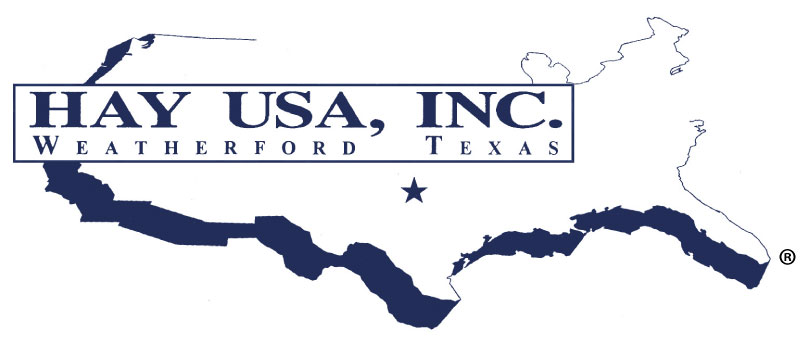 |
|